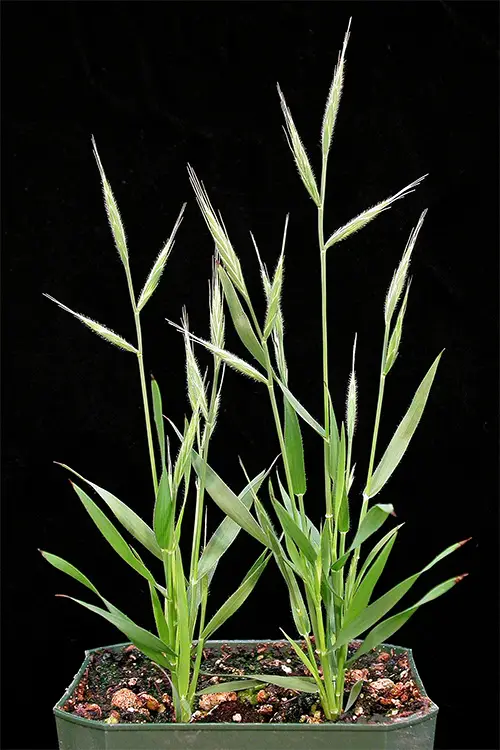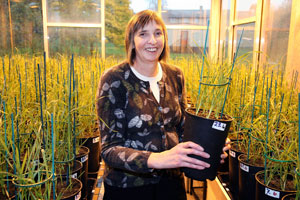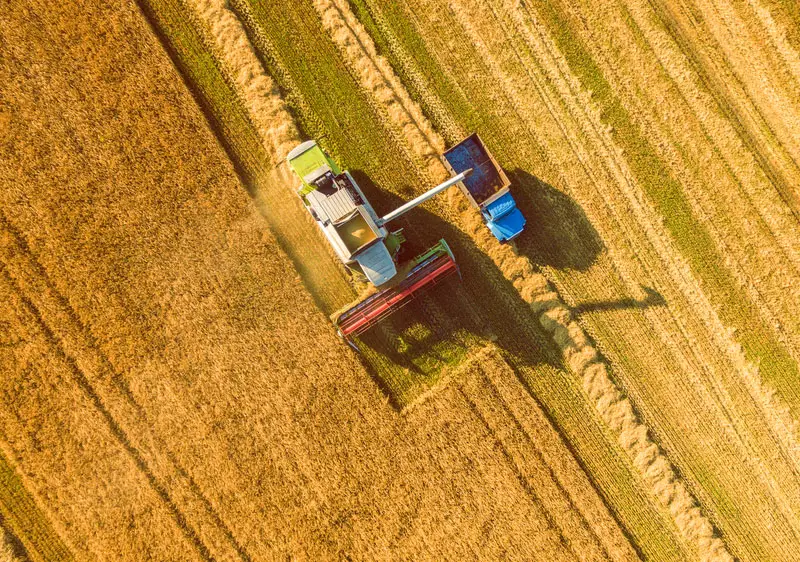
16th November 2016 Genetically modified "superwheat" could boost yields by 40% Researchers in the UK have announced a genetically modified "superwheat" that increases the efficiency of photosynthesis to boost yields by 20 to 40 percent. Field trials are expected in 2017.
With global population expected to reach 10 billion by mid-century, and rapid economic growth in emerging nations, the world's agricultural systems will be under immense pressure. The UN Food and Agriculture Organisation (FAO) estimates that global agricultural production in 2050 will need to increase by at least 60% compared to now. But with arable land declining due to climate change, soil depletion and other environmental issues, achieving this could be a major challenge. Wheat grain is grown on more land area than any other commercial crop and is the most important staple food for humans, but the growth rate in yields has slowed significantly in recent years. This trend is likely to worsen in the future, with a 6% drop in production for every 1°C rise in global temperature. One possible way to increase yields is through genetic engineering. The public tends to be distrusting of such methods, according to most opinion polls. However, the vast majority of scientists agree that genetically modified (GM) foods are safe. The American Association for the Advancement of Science states on its website: "consuming foods containing ingredients derived from GM crops is no riskier than consuming the same foods containing ingredients from crop plants modified by conventional plant improvement techniques." Meanwhile, the U.S. National Academy of Sciences states that "no adverse health effects attributed to genetic engineering have been documented in the human population," and a report issued by the European Commission made the same claim. The World Health Organisation concludes that GM foods "are not likely, nor have been shown, to present risks for human health." None of the GM crops widely grown around the world are currently designed to boost yields directly – but that could be about to change, as scientists in the UK have announced a potentially transformative breakthrough. A team at Rothamsted Research, the longest running agricultural research station in the world, collaborated with the Universities of Essex and Lancaster. They believe it may be possible to increase wheat yields by up to 40%, based on the promising early results of a glasshouse trial. The researchers focused on improving the efficiency of photosynthesis, the process by which energy from sunlight increases plant biomass, by adding genes from a grass called stiff brome (pictured below). The new GM wheat was found to assimilate carbon dioxide better than conventional wheat.
“We have seen yield increases of 20 to 40% in greenhouse pots, although this is not a yield indication for the field,” said Christine Raines from the University of Essex at a briefing. “The efficiency of the process of photosynthesis integrated over the season is the major determinant of crop yield. However, to date, photosynthesis has not been used to select for high yielding crops in conventional breeding programmes and represents an unexploited opportunity. But there is now evidence that improving the efficiency of photosynthesis by genetic modification is one of the promising approaches to achieve higher wheat yield potential.” “In this project, we have genetically modified wheat plants to increase the efficiency of the conversion of energy from sunlight into biomass. We have shown that these plants carry out photosynthesis more efficiently in glasshouse conditions. One of the steps in photosynthesis shown to limit this process is carried out by the enzyme, sedoheptulose-1,7-biphosphatase (SBPase). We have engineered GM wheat plants to produce increased levels of SBPase by introducing an SPBase gene from Brachypodium distachyon (common name stiff brome), a plant species related to wheat and used as a model in laboratory experiments” Raines added.
Rothamsted Research has now applied to the UK's Department for Environment, Food and Rural Affairs (DEFRA) for permission to conduct a field trial of their GM wheat plants. If approved, just under 100sq m of the crop will be grown in Rothamsted’s fenced GM-dedicated growing area from spring 2017. “If we are granted permission to perform a controlled experiment in our already established facilities here at Rothamsted Research, it will be a significant step forward,” said Dr Malcolm Hawkesford, Head of the Plant Biology and Crop Science Department at Rothamsted and the lead scientist for this trial. “We will be able to assess in ‘real environmental conditions’ the potential of these plants to ultimately produce more, using the same resources and land area as their non-GM counterparts. These field trials are the only way to assess the viability of a solution that can bring economic benefits to farmers, returns to the UK tax payer of the long-term investment in this research, benefits to the economy as a whole and the environment in general.”
Dr Elizabete Carmo-Silva, co-investigator in this project at Lancaster University, added: “We have produced two types of plants: one in which two extra copies of SBPase are functional and one in which six extra copies of SBPase are functional. If granted permission to carry out the field trial, we will measure the photosynthetic efficiency of the plants in the field and we will determine total above-ground plant biomass and grain yield on an area basis at full maturity. We will also measure the number of wheat ears on an area basis and the grain number and weight per ear. From this data, we will estimate the harvest index, which is the proportion of biomass allocated to the grain.” The researchers believe wheat yields could be boosted even further, by looking at other enzyme levels. If the field trials are successful, they hope their technique could be applied to other crops too. At present, the only GM crop grown commercially in the EU is maize – mostly in Spain, where it protects against a weevil pest. Opposition to GM food is so high in Europe that no other GM crops have been approved and subsequently grown since 1998. However, George Eustice, the UK's Minister for Agriculture, Fisheries & Food, has suggested that British farmers could grow GM crops once the UK leaves the EU, following the Brexit vote in June. ---
Comments »
|










